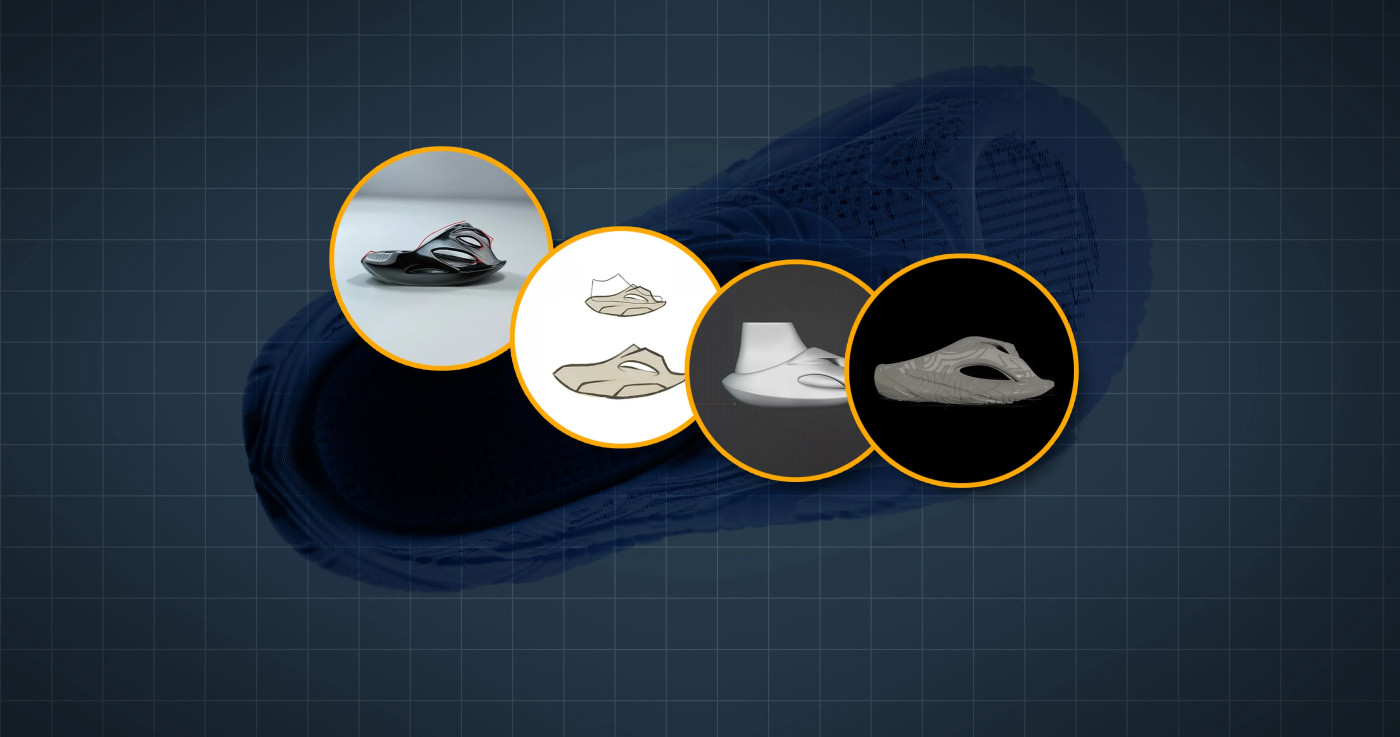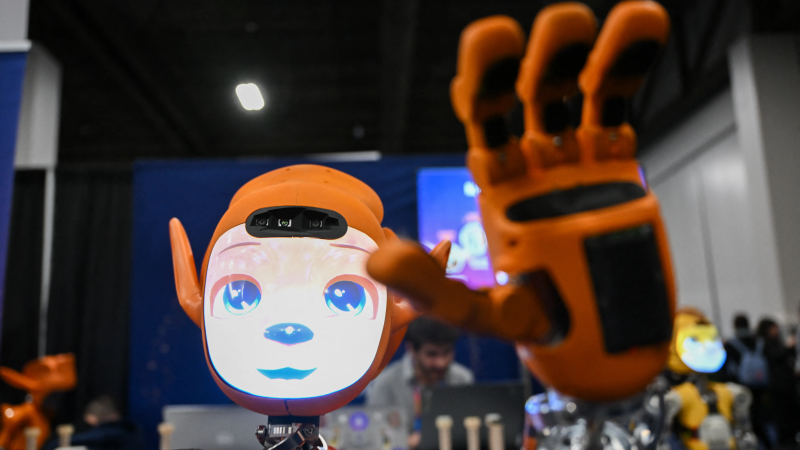
'Classy, yet futuristic': See the first AI-designed, 3D printed shoe available to buy
Sixty-seven years after co-founding Reebok, 89-year-old Joe Foster is now partnering with a 25-year-old entrepreneur to market what the pair say is the first AI-designed commercially available shoe to consumers.
The futuristic-looking shoe designed by Ben Weiss and Foster takes inspiration from the designs of a yacht and a spaceship, they say.
“We wanted to have this classy, yet really futuristic feeling to it,” said Weiss, CEO of Syntilay, a Fort Lauderdale, Florida-based company.
Other shoe companies have 3D printed shoes; Nike and adidas have both unveiled such footwear. They do not appear to be widely available yet to the public and are available in limited quantities on secondary marketplaces. Foster and Weiss say their product, designed with the help of AI technology is a first for a commercially sold, fully-3D printed shoe available to the public. The Syntilay shoe launches Jan. 22.
The shoe – which is a slider, not a sneaker – is designed on top to look like the bridge of a yacht, Weiss said.
How are AI designed, 3D-printed shoes designed and manufactured?
AI technology – including Chat GPT – was essential to the Syntilay team being able to create the shoe's appearance. "Otherwise, with traditional (design), it may have looked very different,” said Weiss.
Weiss and his team used concept images with AI technology to create the design. Using the inspiration of a yacht and spaceships, the team also asked AI to take the artwork of famous sci-fi artist Syd Mead, who made designs for sci-fi films such as Blade Runner, Aliens and Tron, to incorporate into the slide.
The team also used AI to figure out the exact shading of the shoe, Weiss said.
“It went from the first stages of these concepts, generating the artwork, then we had our designer make a sketch based on that, which saves a lot of time because you know exactly where you want to be at. Then the team used AI to generate a 3D model from the sketch,'' said Weiss.
“The unique aspect of it is that nobody has designed a commercially available shoe designed by AI,'' he added. "We’ve seen some concept images teased up with different products, but none of it has been really feasible.”
Some human oversight went into the shoe, but 70% of the shoe’s design was done using AI, he said.
John Kim, editor-in-chief of Sneaker News, said he doesn't think AI-designed 3D shoes are going to resonate long-term with the general public.
"There might be some short-term novel appeal, but the sneaker and fashion community ultimately cherishes the distinct human eye behind footwear design (and design as a whole)," Kim said. "For example, Kanye West is building an AI team within his Yeezy brand, but ultimately it is Kanye West that is the sole factor in driving interest and without him, the brand no longer exists."
AI could be used to assist the creation to some degree like what Nike and adidas has done, Kim said, "but a 100% AI-designed sneaker has limited potential because it lacks the human essence and brand DNA."
AI design in general is inconsequential to driving consumer interest, Kim said. "Consumers tend to make choices based on personal fashion, social clout, budget, or comfort. AI-designed shoes don’t really fall in the first three categories, so unless the shoe is significantly more comfortable than its competitors, it's hard to see AI-design alone driving interest.
AI shoe designers hope to get ahead of a trend
Weiss, however, and his investors, which include Weiss, his father, Farley Weiss, and entrepreneur Murray Friedman, hope to be ahead of the curve on a trend – designing consumer products via AI. He hopes the company can eventually design AI-gear for celebrities and influencers, along with everyday consumers.
“We think it’s going to be a big trend, likely for other types of fashion-apparel products,'' he said. "It’s a much more efficient way to design things.”
Another unique feature is the use of AI to make sure the shoe fits you exactly.
The consumer's foot is scanned via a smartphone program to the consumer’s foot specifications and then 3D printed.
“It’s supposed to be the best fit you can possibly get,” he said. There are also still regular shoe size references if a consumer does not have access to a smartphone for the more customized fit, Weiss said.

AI brings the future to shoe designs, Reebok founder says
For Foster, who took the Reebok brand and turned it into a popular company for aerobic activities, the idea of being part of a shoe designed with AI is exciting.
“You’re not going to get volume, but you’re going to get history,” said Foster, by video chat.
Joe and his wife, Julie, are among six advisers for Weiss’ company, Syntilay. Another adviser includes Kevin Harrington, one of the original sharks on the TV show, Shark Tank.
While athletic shoes were his bread and butter when he was at Reebok, Joe Foster, who stepped back from Reebok in 1990, said he now believes that sliders and clogs are the new hot item.
Similar to how Reebok was able to pivot from a running shoe company to a leader in aerobic shoes and products when it saw where the business needed to move, Foster said he believes Syntilay can pivot if needed.
But to start, the company is banking on the popularity of slides.
Is the AI-designed slide available now?
The shoe is available now via the company’s website, www.syntilay.com. The shoes come in “standard” sizes, though each shoe is customized to the consumer’s foot using a scanning program on the phone.
There are currently five colors – orange, red, beige, black and blue – costing $149.99 each.
Each shoe is individually 3D printed for the particular buyer at a facility in Germany, Weiss said. Weiss said Syntilay was specific in trying not to do any manufacturing in China, which could have potentially changed the price of the product with President Donald Trump proposing tariffs be put on products imported from China, Canada and Mexico.
To start, the company will probably not make more than a couple thousand pairs given “how expensive they are to make and just the constraints with typical 3D printing where we are today,”said Weiss.
Turnaround time for consumers will be four to six weeks after ordering, though Weiss said he hopes to shorten that to two to three weeks with each order before shipping.

What is different about this shoe?
Weiss said the detail in the shoe, including the patterns on the bottom, which add to the traction, make it stand out from others in the slide category.
The company is also banking that the popularity of slides will be big with the work-from-home culture.
“People are wearing slides all over the place," he said.
Tariffs, inflation, and retailersHow Trump's potential tariffs could hit your wallet
What’s the future of Syntilay’s futuristic shoe and company?
Weiss said this is the first step toward using AI to design shoes and other individualized products for consumers.
“I think a lot of people will really enjoy wearing something that’s on the cutting edge on this,” Weiss said.
Betty Lin-Fisher is a consumer reporter for USA TODAY. Reach her at [email protected] or follow her on X, BlueSky, Facebook or Instagram @blinfisher and . Sign up for our free The Daily Money newsletter, which will include consumer news on Fridays, here. Stephen J. Beard is a graphics journalist on the USA TODAY Graphics team. Reach him at [email protected] or @StephenBeard on X and BlueSky.

